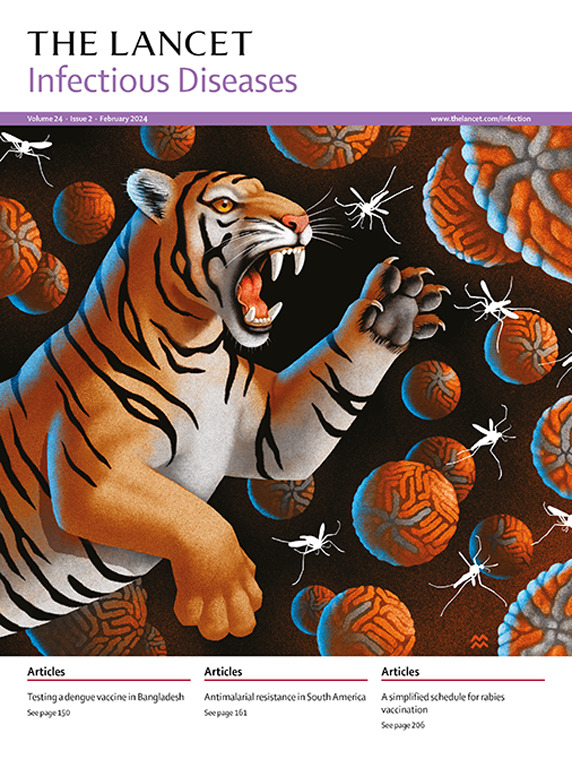The effect of pertussis vaccination in pregnancy on the immunogenicity of acellular or whole-cell pertussis vaccination in Gambian infants (GaPS): a single-centre, randomised, controlled, double-blind, phase 4 trial
IF 36.4
1区 医学
Q1 INFECTIOUS DISEASES
引用次数: 0
Abstract
Background
Vaccinating women against pertussis in pregnancy protects young infants from severe disease and death. Vaccination-induced maternally derived antibodies, however, might subsequently modulate (and specifically blunt) the infant's serological response to their primary series of pertussis vaccinations. We examined the effect of pertussis immunisation in pregnancy on the immunogenicity of primary acellular or whole-cell pertussis vaccines in a west African cohort.Methods
GaPs was a randomised, controlled, double-blind, phase 4 trial conducted in The Gambia. We used a predefined block randomisation scheme to randomly assign healthy, HIV-negative, pregnant participants (1:1) to receive a pertussis-containing (tetanus-diphtheria-acellular pertussis-inactivated polio virus [Tdap-IPV]) or tetanus-toxoid only vaccine at 28–34 weeks' gestation. At the same time, their infants were randomly assigned (1:1) to receive diphtheria-tetanus-acellular pertussis (DTaP) or diphtheria-tetanus-whole-cell pertussis (DTwP) primary vaccine at 8, 12, and 16 weeks postnatally. Participants and trial staff were masked to the allocation of the maternal vaccine. The field team and participants became unmasked to the allocation of the infant vaccine at 16 weeks; laboratory staff and all other investigators remained masked to infant vaccine allocation until the end of the trial. The primary outcome was geometric mean concentration (GMC) of infant pertussis toxin-specific antibodies at 20 weeks and 9 months postnatally and was assessed in infants who received all three doses of the primary vaccine. Secondary outcomes included memory B-cell responses, and exploratory outcomes were total pertussis-specific antibody binding concentrations and functional antibody titres (pertussis toxin-specific neutralising activity [PTNA] and serum bactericidal activity [SBA]). Vaccine reactogenicity was assessed in mothers and infants for 3 days after each vaccine dose. Pregnant women had an extra safety visit 7 days after vaccination. The study is registered with ClinicalTrials.gov, NCT03606096.Findings
Between Feb 13, 2019, and May 17, 2021, we enrolled 343 maternal–infant pairs. 239 (77%) infants were included in the per-protocol immunogenicity analysis. Among infants of mothers receiving Tdap-IPV in pregnancy, at 20 weeks postnatally, the GMCs of anti-pertussis toxin IgG were more than three-fold lower in infants vaccinated with three doses of DTwP (n=64) than in infants vaccinated with three doses of DTaP (n=53; adjusted geometric mean ratio 0·28, 98·75% CI 0·16–0·50). This difference persisted up to 9 months (0·31, 0·17–0·55). Conversely, among infants born to tetanus toxoid-immunised mothers, post-vaccination GMCs of anti-pertussis toxin IgG at 9 months were higher in those vaccinated with DTwP (n=58) than in those vaccinated with DTaP (n=64; 2·02, 1·15–3·55). Tdap-IPV immunisation in pregnancy blunted anti-pertussis toxin IgG following primary vaccination in all infants but particularly in those receiving DTwP, with GMCs of anti-pertussis toxin IgG more than eight-fold lower in DTwP-vaccinated infants born to Tdap-IPV-vaccinated mothers than in DTwP-vaccinated infants born to tetanus toxoid-immunised mothers (0·12, 98·75% CI 0·07–0·22 at 20 weeks; 0·07, 0·03–0·17 at 9 months). Similarly, DTwP-vaccinated infants born to Tdap-IPV-vaccinated mothers also showed significant blunting of PTNA, SBA, total pertussis-specific antibody binding, and memory B-cell responses after primary immunisation, whereas minimal blunting was observed among DTaP-vaccinated infants. However, the absolute levels of these responses generated by DTwP-vaccinated infants remained similar to or, in many cases, were higher than those generated by DTaP-vaccinated infants. There was no difference in reactogenicity between the two maternal vaccines, with most reactions graded 0 or 1. There were no serious adverse events related to vaccination or trial participation.Interpretation
Vaccinating women with Tdap-IPV in pregnancy was safe and well tolerated in a sub-Saharan African setting and boosted the quantity and quality of pertussis-specific antibodies in infants in early life. Although Tdap-IPV was associated with relative blunting of the immune response to the DTwP primary vaccination series, pertussis-specific antibody quality and memory B-cell responses were nevertheless preserved, regardless of the vaccine given during pregnancy.Funding
GaPs was conducted as part of the Pertussis Correlates Of Protection Europe (PERISCOPE) consortium, which received funding from the Innovative Medicines Initiative 2 Joint Undertaking under grant agreement 115910. This Joint Undertaking receives support from the EU's Horizon 2020 research and innovation programme, the European Federation of Pharmaceutical Industries and Associations, and the Bill & Melinda Gates Foundation.妊娠期百日咳疫苗接种对冈比亚婴儿无细胞或全细胞百日咳疫苗免疫原性的影响(gap):一项单中心、随机、对照、双盲、4期试验
背景:在怀孕期间为妇女接种百日咳疫苗可以保护婴儿免受严重疾病和死亡。然而,疫苗诱导的母源抗体可能随后调节(特别是减弱)婴儿对百日咳疫苗初级系列的血清学反应。我们在西非队列研究了妊娠期百日咳免疫接种对原代无细胞百日咳疫苗或全细胞百日咳疫苗免疫原性的影响。方法gaps是一项在冈比亚进行的随机、对照、双盲、4期试验。我们使用预先定义的块随机方案,随机分配健康的、hiv阴性的怀孕参与者(1:1),在妊娠28-34周时接种含百日咳(破伤风-白喉-无细胞百日咳-灭活脊髓灰质炎病毒[Tdap-IPV])或破伤风-类毒素疫苗。同时,他们的婴儿被随机分配(1:1)在出生后8、12和16周接受白喉-破伤风-无细胞百日咳(DTaP)或白喉-破伤风-全细胞百日咳(DTwP)一次疫苗。参与者和试验工作人员不知道产妇疫苗的分配情况。实地小组和参与者在16周时开始了解婴儿疫苗的分配情况;直到试验结束,实验室工作人员和所有其他调查人员都对婴儿疫苗分配保持保密。主要结局是出生后20周和9个月婴儿百日咳毒素特异性抗体的几何平均浓度(GMC),并在接受所有三剂一次疫苗的婴儿中进行评估。次要结果包括记忆b细胞反应,探索性结果是百日咳特异性抗体结合浓度和功能性抗体滴度(百日咳毒素特异性中和活性[PTNA]和血清杀菌活性[SBA])。在每次疫苗剂量后3天对母亲和婴儿进行疫苗反应性评估。孕妇在接种疫苗后7天进行了额外的安全访问。该研究已在ClinicalTrials.gov注册,编号NCT03606096。在2019年2月13日至2021年5月17日期间,我们招募了343对母婴。239名(77%)婴儿被纳入按方案免疫原性分析。在怀孕期间接受Tdap-IPV的母亲的婴儿中,在出生后20周,接种三剂DTwP的婴儿(n=64)的抗百日咳毒素IgG的gmc比接种三剂DTaP的婴儿(n=53)低3倍以上;校正几何平均比为0.28,CI为98.75%,CI为0.16 - 0.50)。这种差异持续了9个月(0.31,0.17 - 0.55)。相反,在接种破伤风类毒素疫苗的母亲所生的婴儿中,接种DTwP疫苗的婴儿(n=58)在接种后9个月时抗百日咳毒素IgG的gmc高于接种DTaP疫苗的婴儿(n=64;2·02,1 * 3 * 55)。妊娠期接种Tdap-IPV疫苗使所有婴儿在初次接种疫苗后抗百日咳毒素IgG减弱,尤其是那些接种白喉破喉疫苗的婴儿,接种Tdap-IPV疫苗的母亲所生的DTwP疫苗婴儿的抗百日咳毒素IgG的gmc比接种破伤风类毒素疫苗的母亲所生的DTwP疫苗婴儿的gmc低8倍以上(0.12,98.75% CI 0.07 - 0.22);0.07, 0.03 - 0.17(9个月)。同样,接种过tdap - ipvv疫苗的母亲所生的接种过dtwp疫苗的婴儿在初次免疫后也表现出PTNA、SBA、百日咳特异性抗体结合和记忆b细胞反应的明显钝化,而接种过dtap疫苗的婴儿则表现出最小的钝化。然而,接种dtwp疫苗的婴儿产生的这些反应的绝对水平仍然与接种dtap疫苗的婴儿产生的反应相似,或者在许多情况下高于接种dtap疫苗的婴儿产生的反应。两种母源疫苗的反应原性没有差异,大多数反应等级为0或1。没有与接种疫苗或参与试验相关的严重不良事件。解释:在撒哈拉以南非洲地区,在怀孕期间为妇女接种Tdap-IPV疫苗是安全且耐受性良好的,并提高了婴儿早期百日咳特异性抗体的数量和质量。尽管Tdap-IPV与DTwP一次接种系列的免疫反应相对减弱有关,但无论在妊娠期间接种何种疫苗,百日咳特异性抗体质量和记忆性b细胞反应都得以保留。资助缺口作为百日咳相关保护欧洲(PERISCOPE)联盟的一部分进行,该联盟根据赠款协议115910从创新药物倡议2联合事业获得资助。这项联合承诺得到了欧盟“地平线2020”研究和创新计划、欧洲制药工业和协会联合会以及法案和协会的支持。梅琳达·盖茨基金会。
本文章由计算机程序翻译,如有差异,请以英文原文为准。
求助全文
约1分钟内获得全文
求助全文
来源期刊

Lancet Infectious Diseases
医学-传染病学
CiteScore
60.90
自引率
0.70%
发文量
1064
审稿时长
6-12 weeks
期刊介绍:
The Lancet Infectious Diseases was launched in August, 2001, and is a lively monthly journal of original research, review, opinion, and news covering international issues relevant to clinical infectious diseases specialists worldwide.The infectious diseases journal aims to be a world-leading publication, featuring original research that advocates change or sheds light on clinical practices related to infectious diseases. The journal prioritizes articles with the potential to impact clinical practice or influence perspectives. Content covers a wide range of topics, including anti-infective therapy and immunization, bacterial, viral, fungal, and parasitic infections, emerging infectious diseases, HIV/AIDS, malaria, tuberculosis, mycobacterial infections, infection control, infectious diseases epidemiology, neglected tropical diseases, and travel medicine. Informative reviews on any subject linked to infectious diseases and human health are also welcomed.
 求助内容:
求助内容: 应助结果提醒方式:
应助结果提醒方式:


